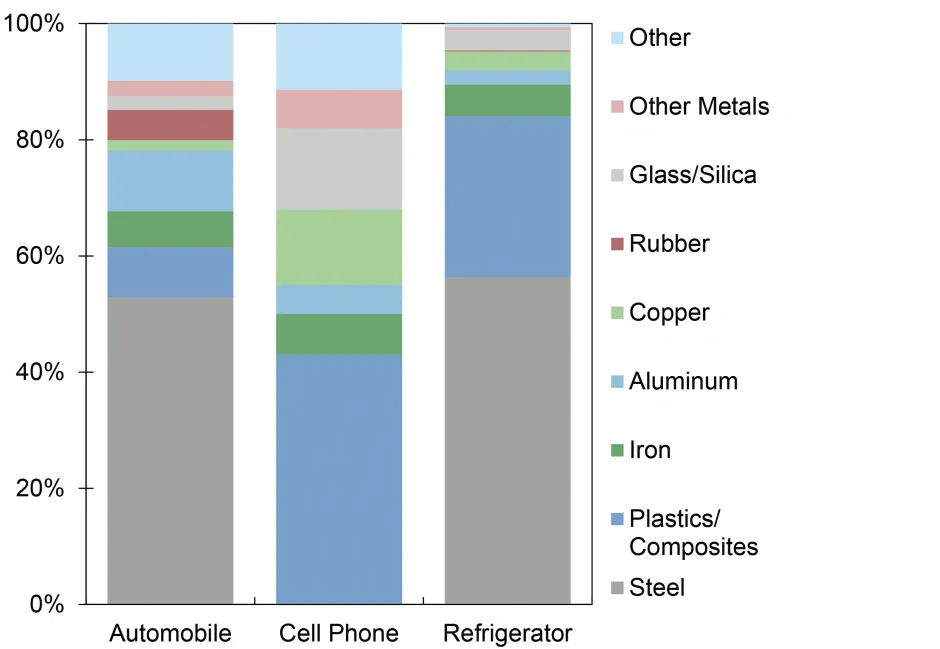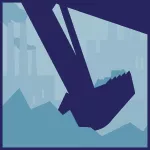U.S. Material Use Factsheet
Patterns of Use
Raw materials are extracted, converted to engineered and commodity materials, and manufactured into products. After use, they are disposed of or returned to the economy through reuse, remanufacturing, or recycling. Sustainability in material use has three components: 1) the relationship between the rate of resource consumption and the overall stock of resources; 2) the efficiency of resource use in providing essential services; and 3) the proportion of resources leaking from the economy and impacting the environment. The first two topics reflect the sustainability of resource supply, while the third affects the sustainability of ecosystems. The United States is a primary user of natural resources, including fossil fuels and materials.
U.S. Nonfuel Material Consumption, 1900-20201

- U.S. raw material (non-fossil fuel or food) use rose 3.23 times more than the population from 1910 to 2020.1,2,3
- After rising 54% from 1970 to 2005, total material consumption in the U.S. (including fuels and other materials) reached 7.8 billion metric tons (Gt) in 2019, which is still 34% higher than 1970 levels of material consumption.4
- In 2019, U.S. per capita total material consumption (including fuels) was 23.75 metric tons (t), 88% higher than Europe.5
- U.S. raw material use increased by 30% from 1996 to 2006, but decreased 32% from 2006 to 2010 following the global financial crisis. By 2020, U.S. raw material use had increased by 20% to over 3 Gt.1
- Construction materials, including stone, gravel, and sand, account for around three-quarters of raw materials use.1
- The use of renewable materials decreased dramatically over the last century—from 41% to 5% of total materials by weight—as the U.S. economy shifted from agriculture to industrial production.6
- The ratio of global reserve to production rate is an indicator of the adequacy of mineral supplies; it can range from a few centuries (aluminum, chromium, iron, lithium, platinum, phosphate rock), to several decades (copper and gold).7
- Rare earth elements (REEs) are a group of 17 elements used in metal alloys, batteries, and as catalysts, with 74% used as catalysts.7,8 Substitutes for REEs are available but are less effective.7 China controlled more than 60% of REE production in 2021.7
Intensity of Raw Material Use
- Material intensity of use refers to the amount of material consumed per unit of economic output, generally measured by the total gross domestic product (GDP) of a country.10 The domestic processed output, or total weight of materials and emissions produced by the domestic economy, declined per unit of GDP by about 44% in the U.S. over the last few decades, similar to other industrialized nations.11
- 44% of materials used in the U.S. economy are added to long-term (+30 years) domestic stock, 2% remain in stock between 2-30 years, 39% remain in stock less than 2 years, and the remaining 15% are recycled back into the economy.11
- Of the materials remaining in domestic stock less than 30 years, 73% are released into the atmosphere (mostly through fossil fuel combustion), 18% are disposed of in controlled areas (e.g., landfills, tailings ponds), and the remaining 9% are dispersed directly into the environment on land, in water, or through multiple paths.11
- There has been an appreciable decline in the use intensity of primary metals (except aluminum), while plastics use continues to grow.12
- The composition of materials used in the U.S. economy has become less dense, i.e., less iron and steel and more lighter metals, plastics, and composites.13
Intensity of Use of Selected Materials in the U.S., 1980-20201,9

MATERIAL COMPOSITION OF SELECTED PRODUCTS14,15,16

Environmental Impacts
- In 2017, it was estimated that only 8% of plastics disposed of in the U.S. were recycled. A further 2% “leaked” into the environment, often in the form of microplastics from tire abrasion and synthetic textiles, which is of growing concern globally due to impacts on organisms and unknown health consequences in humans.17
- Mines and quarries, including coal but excluding oil and natural gas, occupy 0.3% of the land area in the U.S., of which 60% is used for excavation and the rest for disposal of overburden and other mining wastes.18
- As higher grade reserves are depleted, the quality of metal is degrading, leading to greater energy needed to extract and process ore, and thus greater releases of gases that contribute to climate change and acid precipitation.19
- The primary metals and metal mining sectors accounted for 52% of the total 3 billion pounds of toxic releases in 2021.20
- In 2021, almost 36 million metric tons (Mt) of Resource Conservation and Recovery Act (RCRA) regulated hazardous waste were generated in the U.S. The largest sources were chemical manufacturing (61%) and petroleum and coal products manufacturing (14%).21
- In 2018, nonmetallic mineral (stone, clay, glass, cement) manufacturing used 0.8 quads (1 quad = 10¹⁵ Btu) of energy; primary metal industries used 1.5 quads; petroleum/coal products used 4.2 quads; chemical manufacturing used 7.1 quads (total U.S. consumption was 101.2 quads).22,23
- Energy-related CO2 emissions from the industrial sector have fallen 23% since 2000, mainly due to a shift away from energy-intensive manufacturing in the U.S. economy.23
- Human health risks arise from emissions and residues over a material’s life cycle. In many cases, pollutant releases have been substantially reduced from historical levels, e.g., mercury released by gold mining, fugitive volatile organic compound emissions from paints, and lead from gasoline combustion.24 However, in 2021, more than 228,000 U.S. short tons (tons) of lead and lead compounds were released; 86% came from metal mining, while metal production and electric utilities accounted for 4.5% and 0.6%, respectively.20 New chemicals have been introduced that persist in the environment, bioaccumulate (move up the food chain), and/or are toxic, e.g., per-and polyfluoroalkyl substances (PFAS) which are used in products to make them heat, water, and oil resistant.25,26
U.S. Recovery of Municipal Solid Waste, 1960-201827

Solutions and Sustainable Actions
- Conserve materials: “Reduce, Reuse, Remanufacture, and Recycle.” U.S. recycling and remanufacturing industries accounted for over 681,000 jobs and more than $5.4 billion in tax revenue in 2012.28 In 2018, 32.1% of municipal solid waste in the U.S. was recovered for recycling and composting, diverting more than 93 million tons of material from landfills and incinerators.27
- Change material composition of products: Create products using materials that are less toxic, recyclable, and less energy intensive to make.
- Reduce material intensity: Technological advances can help reduce the raw material intensity of products while making them lighter and more durable. Aluminum beverage cans are 38% lighter today than they were three decades ago, allowing more cans to be produced from the same amount of aluminum.29 Beverage cans are also made with an average of 73% recycled aluminum, representing a huge decrease in energy requirements and greenhouse gas emissions compared to using virgin materials.30
- Promote product stewardship: Appropriate policy and regulatory frameworks can help ensure product manufacturers’ responsibility for the environmentally conscious management of retired products. The European Union’s regulations on waste electrical and electronic equipment (WEEE) included a target of an 85% increase in proper WEEE collection and disposal.31 It also has an Extended Producer Responsibility (EPR) policy that seeks to shift responsibility for life cycle environmental impacts from governments to producers.32
- Encourage renewable material use: Biobased materials such as polylactic acid (PLA), a biodegradable polymer, can provide performance similar to petroleum-based plastics. Manufacturing these materials may require less energy and emits fewer greenhouse gases, but the use of land and chemicals required to grow the feedstock may have adverse environmental consequences.33
Center for Sustainable Systems, University of Michigan. 2023. "U.S. Material Use Factsheet." Pub. No. CSS05-18.
References
- Matos, G.R. (2022) Materials flow in the United States—A global context, 1900–2020: U.S. Geological Survey Data Report 1164, 23 p.
- U.S. Census Bureau (2021) “National Population Totals and Components of Change: 2010-2020.”
- U.S. Census Bureau (2019) “1910 Fast Facts.”
- Organization for Economic Co-operation and Development (OECD) (2023) Total Domestic Material Consumption 1970-2019.
- OECD (2022) Domestic Material Consumption per Capita, 1970-2019.
- Wagner, L. (2002) Materials in the Economy – Material Flows, Scarcity and the Environment. USGS.
- USGS (2022) Mineral Commodity Summaries 2022.
- USGS (2020) 2017 Minerals Yearbook Rare Earths.
- Usafacts (2022) United States Population 1900-2022.
- Cleveland, C. and M. Ruth (1998) “Indicators of dematerialization and the materials intensity of use.” Journal of Industrial Ecology, 2: 15-50.
- World Resources Institute (2007) Material Flows in the United States: A Physical Accounting of the U.S. Industrial Economy.
- Wernick, I. (1996) “Consuming materials – the American way.” Technological Forecasting and Social Change, 53: 111-122.
- Wernick, I. and J. Ausubel (1995) “National material flows and the environment.” Annual Review of Energy and Environment, 20: 462-492.
- U.S. Department of Energy (2021) Transportation Energy Data Book, Edition 39.
- OECD Environment Directorate (2010) Materials Case Study 1: Critical Metals and Mobile Devices.
- Association of Home Appliance Manufacturers (2002) Refrigerators Energy Efficiency and Consumption Trends.
- Heller, M., et al. (2020) “Plastics in the US: Toward a Material Flow Characterization of Production, Markets and End of Life.” Environmental Research Letters, 15(9)
- Kesler, S. (2015) Mineral Resources, Economics and the Environment. Cambridge University Press, Cambridge, United Kingdom.
- Norgate, T. and W. Rankin (2002) “The role of metals in sustainable development.” Proceedings, International Conference on the Sustainable Processing of Minerals: 177-184.
- U.S. EPA (2023) Toxic Release Inventory Explorer.
- U.S. EPA (2022) The National Biennial RCRA Hazardous Waste Report.
- U.S. Energy Information Administration (EIA) (2021) Manufacturing Energy Consumption Survey 2018.
- U.S. EIA (2023) Monthly Energy Review April 2023.
- Commission for Environmental Cooperation (2006) Toxic Chemicals and Children’s Health in North America.
- Center for Disease Control and Prevention (2022) “Per- and Polyfluorinated Substances (PFAS) Factsheet.
- U.S. EPA (2023) “PFAS Explained.”
- U.S. EPA (2020) Advancing Sustainable Materials Management: 2018 Fact Sheet.
- U.S. EPA (2020) U.S. Recycling Economic Information Study.
- The Aluminum Association (2017) The Aluminum Can Advantage Key Sustainability Performance Indicators.
- The Aluminum Association (2021) The Aluminum Can Advantage Key Sustainability Performance Indicators.
- European Commission (2012) Statement by Commissioner Potocnik on the new directive on waste electrical and electronic equipment (WEEE).
- European Commission (2019) Development of Guidance on Extended Producer Responsibility (EPR).
- Weiss, M., et al. (2012) “A review of the environmental impacts of biobased materials.” Journal of Industrial Ecology, 16: S169-S181.
